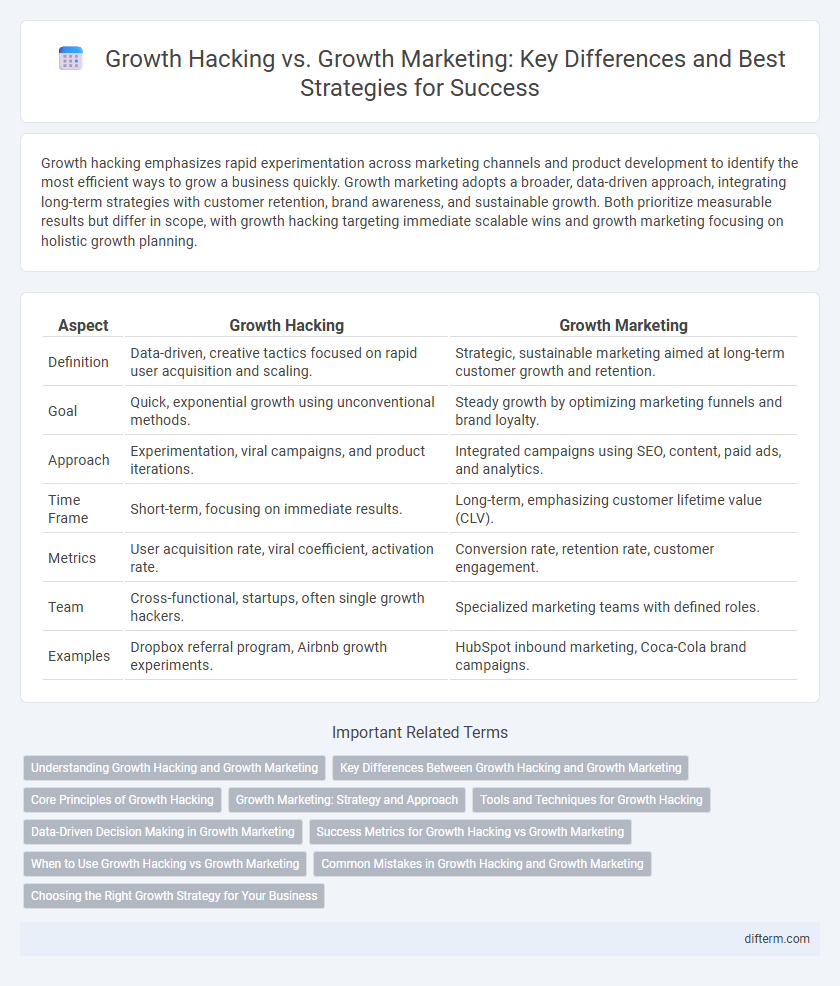Growth hacking emphasizes rapid experimentation across marketing channels and product development to identify the most efficient ways to grow a business quickly. Growth marketing adopts a broader, data-driven approach, integrating long-term strategies with customer retention, brand awareness, and sustainable growth. Both prioritize measurable results but differ in scope, with growth hacking targeting immediate scalable wins and growth marketing focusing on holistic growth planning.
Table of Comparison
| Aspect | Growth Hacking | Growth Marketing |
|---|---|---|
| Definition | Data-driven, creative tactics focused on rapid user acquisition and scaling. | Strategic, sustainable marketing aimed at long-term customer growth and retention. |
| Goal | Quick, exponential growth using unconventional methods. | Steady growth by optimizing marketing funnels and brand loyalty. |
| Approach | Experimentation, viral campaigns, and product iterations. | Integrated campaigns using SEO, content, paid ads, and analytics. |
| Time Frame | Short-term, focusing on immediate results. | Long-term, emphasizing customer lifetime value (CLV). |
| Metrics | User acquisition rate, viral coefficient, activation rate. | Conversion rate, retention rate, customer engagement. |
| Team | Cross-functional, startups, often single growth hackers. | Specialized marketing teams with defined roles. |
| Examples | Dropbox referral program, Airbnb growth experiments. | HubSpot inbound marketing, Coca-Cola brand campaigns. |
Understanding Growth Hacking and Growth Marketing
Growth hacking focuses on rapid experimentation across marketing channels and product development to identify the most effective ways to grow a business quickly, often leveraging low-cost tactics and creative strategies. Growth marketing encompasses a broader, data-driven approach that integrates traditional marketing principles with continuous analysis, testing, and optimization to achieve sustainable, long-term growth. Understanding the distinction involves recognizing growth hacking's emphasis on speed and innovation, while growth marketing prioritizes strategic planning and scalability.
Key Differences Between Growth Hacking and Growth Marketing
Growth hacking emphasizes rapid experimentation across marketing channels and product development to identify the most effective ways to grow a business quickly, often relying on unconventional and low-cost strategies. Growth marketing focuses on long-term, data-driven strategies that optimize the entire customer journey, leveraging analytics, segmentation, and scalable campaigns to sustain consistent growth. Key differences include growth hacking's speed and innovation orientation versus growth marketing's emphasis on strategic planning and scalable, measurable results.
Core Principles of Growth Hacking
Growth hacking centers on rapid experimentation across marketing channels and product development to identify the most effective ways to grow a business, emphasizing creativity, analytics, and agile testing. Core principles include leveraging data-driven decision-making, optimizing the customer acquisition funnel, and prioritizing scalable, cost-effective strategies that maximize growth velocity. Unlike traditional growth marketing, growth hacking often incorporates cross-functional collaboration and unconventional tactics to achieve exponential growth.
Growth Marketing: Strategy and Approach
Growth marketing emphasizes a data-driven, customer-centric strategy that integrates cross-channel campaigns, personalized content, and continuous experimentation to scale sustainable business growth. It leverages marketing automation, analytics, and customer segmentation to optimize the entire funnel while fostering long-term customer relationships. Unlike growth hacking's rapid, short-term tactics, growth marketing prioritizes strategic planning and alignment with overall brand objectives for scalable and measurable results.
Tools and Techniques for Growth Hacking
Growth hacking leverages rapid experimentation with digital tools like A/B testing platforms, analytics software, and marketing automation to optimize user acquisition efficiently. Techniques include viral marketing, data-driven decision-making, and leveraging social media growth loops to accelerate customer base expansion. Unlike traditional growth marketing, growth hacking emphasizes scalable, low-cost methods often driven by cross-functional teams implementing agile iterations.
Data-Driven Decision Making in Growth Marketing
Growth marketing leverages extensive data analytics and user insights to tailor campaigns that maximize customer acquisition and retention, while growth hacking often relies on rapid, experimental tactics with less emphasis on sustained data analysis. Data-driven decision making in growth marketing enables precise targeting, continuous optimization, and measurable ROI, fostering scalable business growth. By systematically analyzing user behavior and campaign performance metrics, growth marketers refine strategies to achieve long-term results beyond quick wins.
Success Metrics for Growth Hacking vs Growth Marketing
Success metrics for growth hacking emphasize rapid experimentation and short-term gains, often measured by user acquisition rates, viral coefficient, and activation metrics. In contrast, growth marketing prioritizes long-term customer value and retention, focusing on metrics such as customer lifetime value (CLV), churn rate, and return on investment (ROI). Growth hacking relies heavily on data-driven insights to optimize funnel conversion, while growth marketing integrates broader performance indicators to sustain scalable business growth.
When to Use Growth Hacking vs Growth Marketing
Growth hacking excels in early-stage startups aiming for rapid experimentation and fast user acquisition with limited resources. Growth marketing suits established businesses focused on sustainable, long-term growth through data-driven strategies and customer lifecycle optimization. Choosing between the two depends on your company's scale, goals, and available budget for growth initiatives.
Common Mistakes in Growth Hacking and Growth Marketing
Common mistakes in growth hacking include relying heavily on short-term tactics without building sustainable customer relationships, neglecting data analysis, and ignoring user feedback, which can lead to scaling inefficiencies. In growth marketing, errors often involve insufficient experimentation and optimization, underestimating the importance of customer retention, and misaligning marketing strategies with overall business goals. Avoiding these pitfalls requires a balanced approach combining rapid testing with long-term strategic planning and continuous data-driven decision-making.
Choosing the Right Growth Strategy for Your Business
Growth hacking emphasizes rapid experimentation across marketing channels and product development to identify the most efficient ways to grow a business, often ideal for startups seeking quick scalability. Growth marketing employs a comprehensive, data-driven approach focusing on long-term customer engagement, retention, and sustainable growth through strategic campaigns and personalized user experiences. Selecting the right growth strategy depends on your business goals, resources, and market stage, ensuring alignment between aggressive scaling efforts and sustainable customer relationship management.
Growth hacking vs growth marketing Infographic

 difterm.com
difterm.com